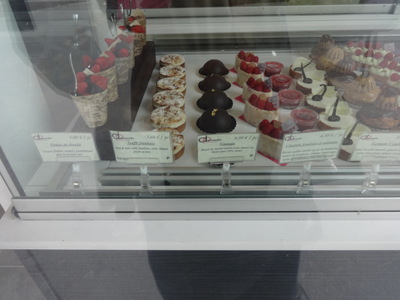
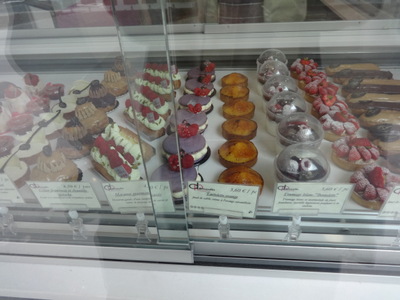 I had some left-over bread, so I heated it in the oven, fried myself an excellent organic egg, and ate another of my little discs of chevre. Highly satisfactory breakfast.
I had some left-over bread, so I heated it in the oven, fried myself an excellent organic egg, and ate another of my little discs of chevre. Highly satisfactory breakfast.Thursday, 14 June, Victor Hugo's house and Le Grand Véfour!
Written 18 June 2018

 I had some left-over bread, so I heated it in the oven, fried myself an excellent organic egg, and ate another of my little discs of chevre. Highly satisfactory breakfast.
I had some left-over bread, so I heated it in the oven, fried myself an excellent organic egg, and ate another of my little discs of chevre. Highly satisfactory breakfast.
Then I headed out to buy postcards. I finally found what I wanted after walking most of the way to Place de la République, but not before being distracted by the lovely windows of a bakery and by this handsome and robust thistle growing at the foot a a small street tree (a "tilieul," Tilia x europaea, linden) in front of an Italian restaurant.
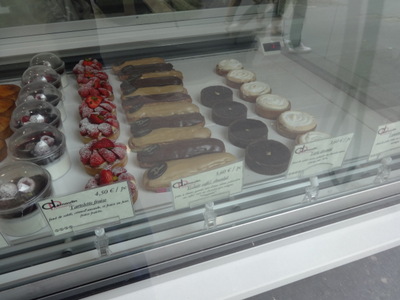
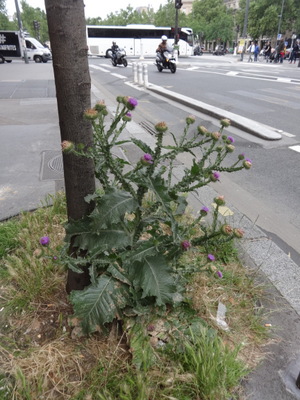
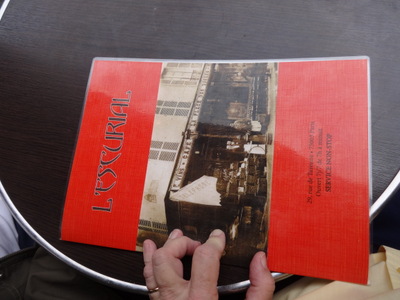
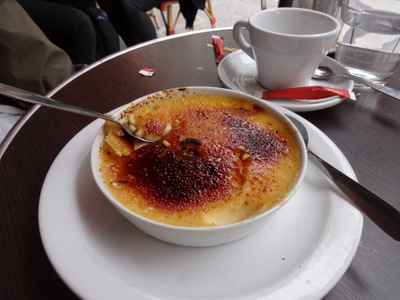 When David finally got up, we caught the #96 bus down to the Place des Vosges. I had scoped out a couple of candidate restaurants in the area, but l'Escurial, right next to the bus stop, looked good, so we just settled there. The service was slow and rather brusque, but our salades Landaises (greens, tomatoes, fois gras, lardons, ham) were excellent—no bruised and rotting greens here—but I'm afraid I forgot to photograph them before we ate them.
When David finally got up, we caught the #96 bus down to the Place des Vosges. I had scoped out a couple of candidate restaurants in the area, but l'Escurial, right next to the bus stop, looked good, so we just settled there. The service was slow and rather brusque, but our salades Landaises (greens, tomatoes, fois gras, lardons, ham) were excellent—no bruised and rotting greens here—but I'm afraid I forgot to photograph them before we ate them.
For dessert, we split a crème brulée, also excellent.
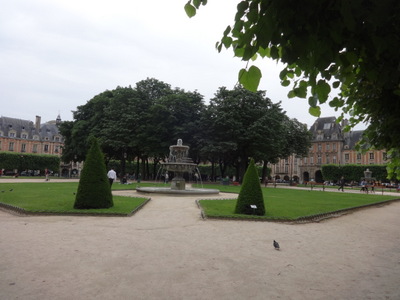
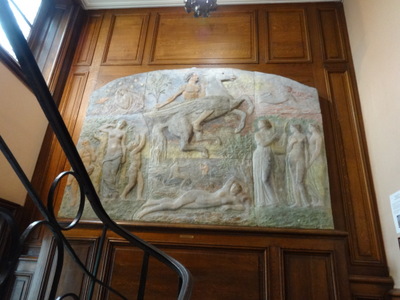 Then, after a brief detour caused by my trying to read the wrong map, we walked over and into the Place des Vosges, a lovely square park enclosed by nicely uniform brick buildings erected in the early 17th century, under Henri IV, and diagonally across it to the far corner (straight ahead in the photo) to visit the apartment where Victor Hugo (1802–1885) lived for many years with his family.
Then, after a brief detour caused by my trying to read the wrong map, we walked over and into the Place des Vosges, a lovely square park enclosed by nicely uniform brick buildings erected in the early 17th century, under Henri IV, and diagonally across it to the far corner (straight ahead in the photo) to visit the apartment where Victor Hugo (1802–1885) lived for many years with his family.
The foundation that runs the museum invites you to visit his other house, which they also manage as a museum, on the island of Guernsey, where he lived in exile 1855–1970 because he openly called Napoleon III a traitor to France for taking the throne. He tried Jersey first, but they threw him out because he also criticized Queen Victoria.
In the staircase up to the floor where the Hugos lived, is this large relieve made of pâte de verre (I'm not sure what it's called in English; glass paste?) depicting the apotheosis of Victor Hugo, commissioned for the opening of the museum just before WWI. Victor is riding a winged horse up into the sky, flanked by muses, personifications of glory, etc. The museum is soliciting contributions to a fund to clean and restore it.
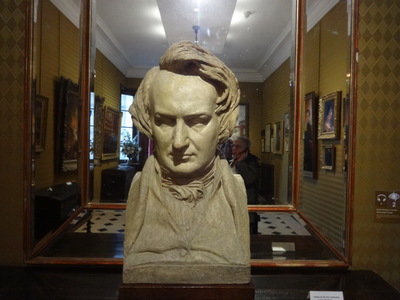
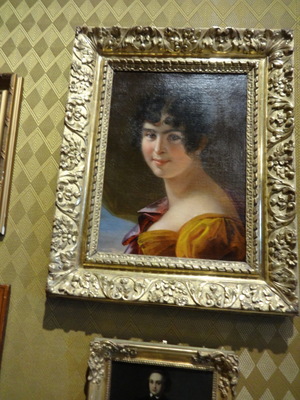 The museum is divided into three sections, each consisting of a couple of rooms: Before, during, and after exile.
The museum is divided into three sections, each consisting of a couple of rooms: Before, during, and after exile.
Hugo was a popular subject for busts. The one here is early, well before the period of exile.
The portrait at the right is of Hugo's childhood sweetheart and wife, Adèle Foucher, whom he apparently loved desperately. They had five children: Leopold, who died in infancy; Leopoldine, who drowned at age 19; Charles and Francois-Victor, who lived to adulthood; and Adèle, who developed schizophrenia in her youth, became obsessed with a British officer, and after following him around the world, was abandoned and finally found wandering and disoriented, identified, and placed in medical care for the rest of her life. Not the happiest of family outcomes.
In 1833, shortly after he was devastated to learn that Adèle was unfaithful to him (not, apparently, entirely without provocation), Juliette Drouet, an actress who was playing Princess Négroni in a production of Hugo's Lucrezia Borgia, more or less threw herself at him, and he caught her with open arms. She gave up the theater to become his secretary, mistress, and companion for the rest of her life.
She aparently wasn't the only mistress he had during that time, but she was certainly the most faithful, dedicated, and useful!
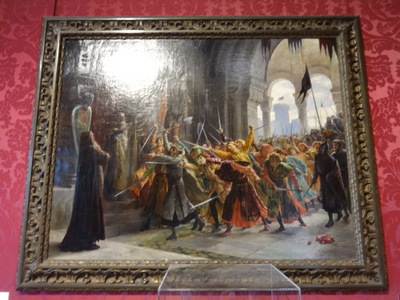
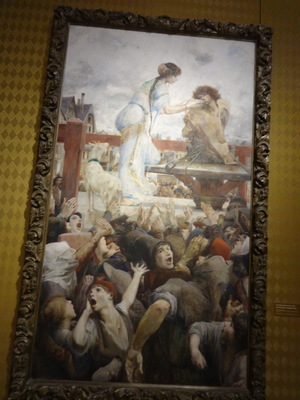 The apartment also houses a lot of works of art inspired by Hugo's writing. In addition to Lucrezia Borgia, Hernani and Ruy Blas were both produced on stage. The former caused riots on opening night. I'm pretty sure the painting at the left is a scene from one of them, but I somehow failed to photograph its label.
The apartment also houses a lot of works of art inspired by Hugo's writing. In addition to Lucrezia Borgia, Hernani and Ruy Blas were both produced on stage. The former caused riots on opening night. I'm pretty sure the painting at the left is a scene from one of them, but I somehow failed to photograph its label.
Painters also took inspiration from his works. At the right is Esmeralda giving a drink of water to the chained Quasimodo. I also somehow failed to photograph its label, so I can't tell you who painted either one.
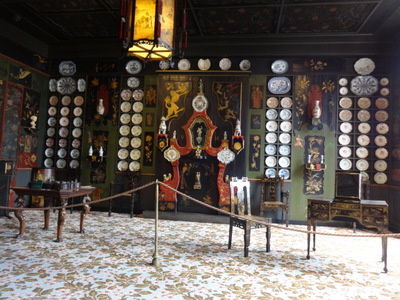
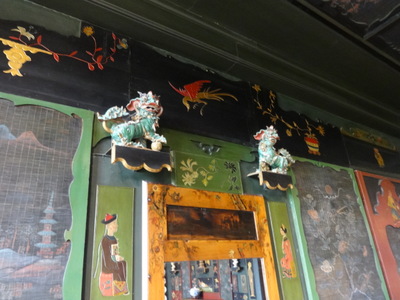 The first of the rooms dedicated to the period of exile is furnished with this dizzying array of Chinoiserie, which he apparently collected.
The first of the rooms dedicated to the period of exile is furnished with this dizzying array of Chinoiserie, which he apparently collected.
The figurines in the photo at the right were directly behind me when I took the photo on the left.
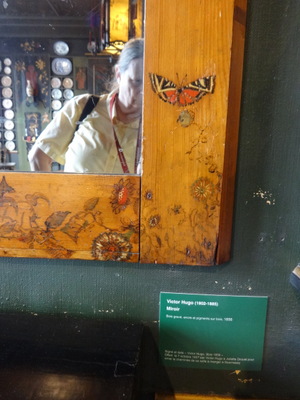
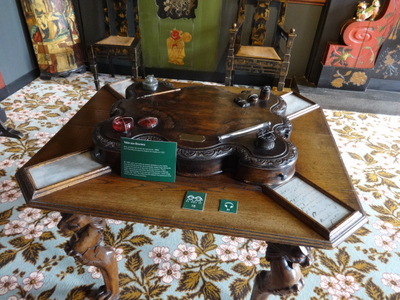 The photo at the left here is of a bottom corner of the mirror in the right-hand photo above. Another hobby of Hugo's was apparently wood engraving and staining. He made his frame himself, and the museum includes several other examples.
The photo at the left here is of a bottom corner of the mirror in the right-hand photo above. Another hobby of Hugo's was apparently wood engraving and staining. He made his frame himself, and the museum includes several other examples.
The story of the ornate little table in the right-hand photo, also displayed in the room full of chinoiserie, began in 1860, on Guernsey, when Adèle Hugo, for a charity sale to support a local orphanage, asked four famous writers (Hugo, Alphonse de Lamartine, Alexandre Dumas, and George Sand) to contribute their inkwells, but at the sale, the collection found no buyer, so Hugo bought it.
In 1903, when the museum was being assembled, Hugo's close friend and collaborator Paul Meurice had the frame and table made to hold them. The frames contain facsimiles of pages of manuscript written with ink from the wells.
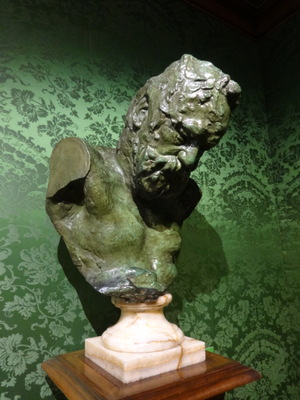
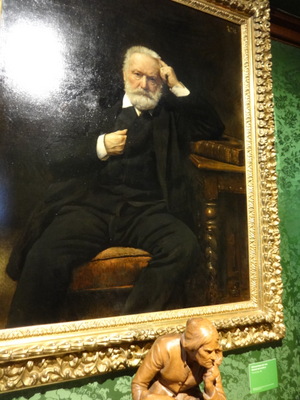 The final room, originally Hugo's bedroom, displayed this much later bust by Rodin and this magnificent portrait by Léon Bonnat.
The final room, originally Hugo's bedroom, displayed this much later bust by Rodin and this magnificent portrait by Léon Bonnat.
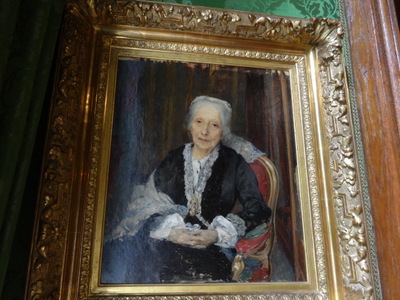
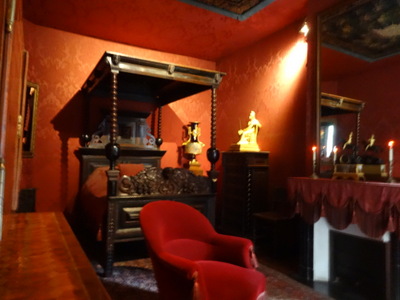 Finally, here's a portrait of Juliette Drouet painted by Jules Bastien-Lepage in 1883, the year she died.
Finally, here's a portrait of Juliette Drouet painted by Jules Bastien-Lepage in 1883, the year she died.
At the right is the bed where Hugo died two years later.
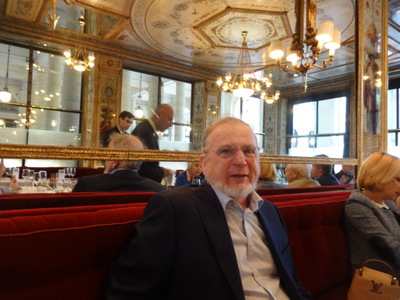
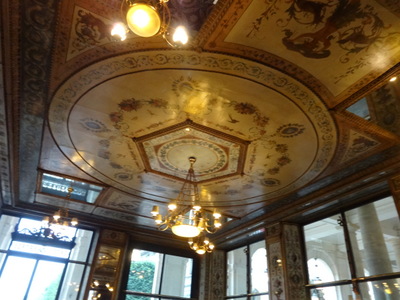 And then dinner. David has long been fascinated by Le Grand Vefour, a serious contender for most expensive and pretentious restaurant in Paris, so this year we decided to give it a try.
And then dinner. David has long been fascinated by Le Grand Vefour, a serious contender for most expensive and pretentious restaurant in Paris, so this year we decided to give it a try.
The place is located in the northern end of the Palais Royale. It was founded in 1784, as the Café de Chartres, and is considered the first "grand restaurant" in Paris. Jean Vefour bought it in 1820 and changed the name. Besides Victor Hugo, whose house we had just toured, Jean Cocteau, Collette, Marcel Pagnole, Jean Genet, André Malraux, Marguerite Moreno, Jean Giraudoux, Sacha Guitry, Louis Aragon, Jean-Paul Sartre, and Simone de Beauvoir ate there. Jean Cocteau designed the menu; sauce Mornay was invented there. Etc., etc.
Here are (left) David with the famous ceiling reflected in the mirror behind him and (right) the famous ceiling itself. When we left, they gave us a postcard of the ceiling.
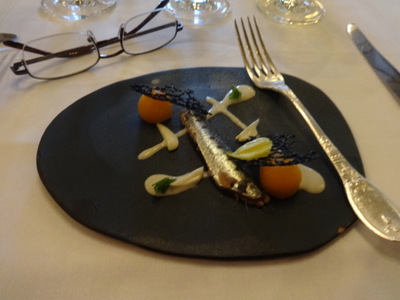
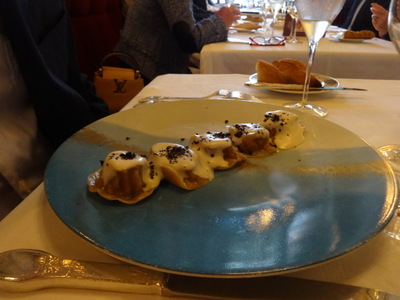 Then just as David's anticipation peaked, they brought us the amuse-bouche of his worst nightmares—marinated raw herring and melon balls. He wouldn't touch it, so I at both mine and his. Not bad, once you got over the shock of biting into a melon ball that had been soaked in lemon juice! The herring was also pretty good.
Then just as David's anticipation peaked, they brought us the amuse-bouche of his worst nightmares—marinated raw herring and melon balls. He wouldn't touch it, so I at both mine and his. Not bad, once you got over the shock of biting into a melon ball that had been soaked in lemon juice! The herring was also pretty good.
His appetizer made it up to him, though. It consisted of a row of five fat ravioli of foie gras topped with a cream sauce and sprinkled with finely chopped truffles. Good thing he gave me one before he tasted them, or I don't think I'd have gotten a bite. The waitress did warn us to eat each one in a single bite, as the contents were liquid and would otherwise splatter. They made kind of a large mouthful, but they were really good (he gave me one, but I think he regretted it once he tasted them himself).
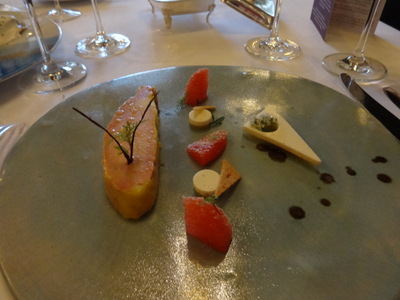
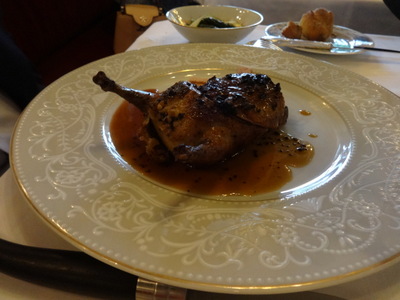 I had the other foie gras starter, in which the stuff was served cold, slightly flavored with vanilla and garnished with grapefruit segments. The white pieces were made of a two-tone stiff jelly. The lower layer was clear, the upper creamy white, and all flavored with grapefruit and vanilla. The two little "antennae" sticking out of the foie gras were dried slivers of spent vanilla bean. The dark spots are part of the glaze on the plate and not, e.g., balsamic vinegar.
I had the other foie gras starter, in which the stuff was served cold, slightly flavored with vanilla and garnished with grapefruit segments. The white pieces were made of a two-tone stiff jelly. The lower layer was clear, the upper creamy white, and all flavored with grapefruit and vanilla. The two little "antennae" sticking out of the foie gras were dried slivers of spent vanilla bean. The dark spots are part of the glaze on the plate and not, e.g., balsamic vinegar.
David's main course was Pigeon "Prince Ranier," which the waiter brought to the table in the pot in which it had been roasted (dusted with herbs) and lifted the cover to show us the bird before he took it away to carve and plate it. As it was already deboned except for the drumsticks and stuffed with foie gras, carving it consisted of cutting it in half at an angle, offsetting the two pieces slightly, and ladling truffle sauce over it. It came with a dish of asparagus, which you can make out in the background.
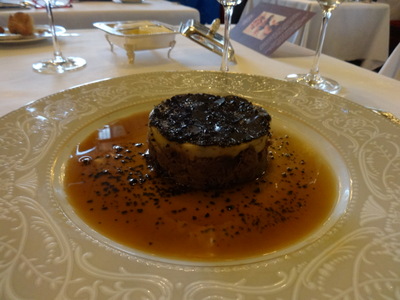
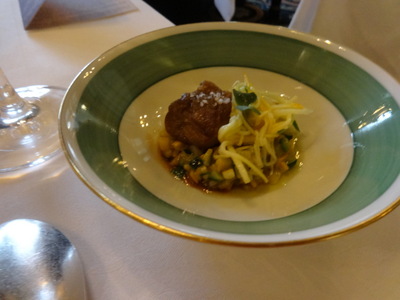 My main course was "Parmentier" of oxtail. Any dish with Parmentier in the title involves potatoes, so I was expecting just what I got—a flat cylinder consisting of shredded oxtail on the bottom and potato on top. The only unusual feature of the dish was the layer of black truffle on top. As I've said many times before, truffles do very little for me, and such was the case here. I didn't think they added anything to the dish which was no better than (in fact not as good as) the wonderful braised veal cheek at Chez l'Ami Jean. This was just pot roast and mashed potato.
My main course was "Parmentier" of oxtail. Any dish with Parmentier in the title involves potatoes, so I was expecting just what I got—a flat cylinder consisting of shredded oxtail on the bottom and potato on top. The only unusual feature of the dish was the layer of black truffle on top. As I've said many times before, truffles do very little for me, and such was the case here. I didn't think they added anything to the dish which was no better than (in fact not as good as) the wonderful braised veal cheek at Chez l'Ami Jean. This was just pot roast and mashed potato.
The side dish was a tasty mixture of diced and shredded summer squashes of different colors accompanied by a brown cube which turned out to be beef marrow.
The other side dish, which we both (and everyone else in the place, as far as I could tell) got was a bowl of mashed potato topped with a rich meat reduction sauce. Now, when David ordered the pigeon, the waiter anxiously pointed out that it would contain foie gras, as thought the duplication with David's starter might be a problem (it wasn't), but these same people found nothing odd about serving me a big bowl of mashed potatoes with a dish that already consisted of about 50% mashed potato!
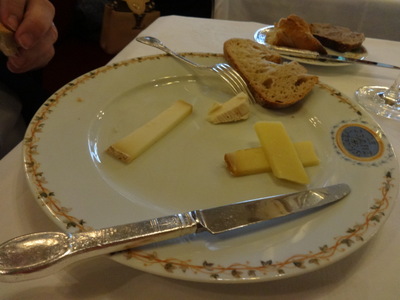
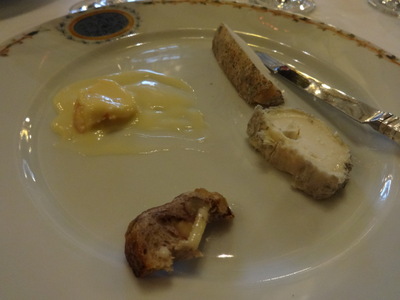 For the cheese course, David selected Beaufort (alpine vache), some Ossau-Iraty (Basque brebis), and some Banon (chevre wrapped in chestnut leaves).
For the cheese course, David selected Beaufort (alpine vache), some Ossau-Iraty (Basque brebis), and some Banon (chevre wrapped in chestnut leaves).
I had Époisse (vache, making a break for it across the plate), some St. Maur (a cylindrical ashed chevre), and a wedge of an extremely dry, chalky chevre I didn't catch the name of. The object at 6 o'clock on the plate is a piece of the special nut bread they gave us to eat with the cheese. All six choices were excellent, but boy that dry chevre could suck all the moisture right out of your head and halfway down your esophagus!
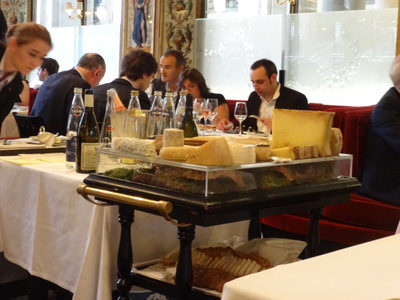
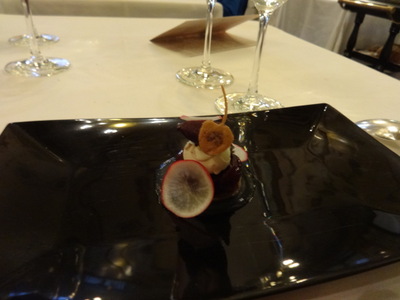 At the left here is the cheese trolley we made our choices from. Strangely, it included no blue cheese of any kind, very unusual in a French restaurant.
At the left here is the cheese trolley we made our choices from. Strangely, it included no blue cheese of any kind, very unusual in a French restaurant.
At the right is our "predessert," a small concoction of cherries and radishes. The dark cherry-colored gel didn't photograph well against the black plate, but perhaps you can make out the amazing little pastry fleuron in the shape of a cherry that was perched on top. With its stem, it was perhaps an inch tall, crisp, and infinitessimally thin.
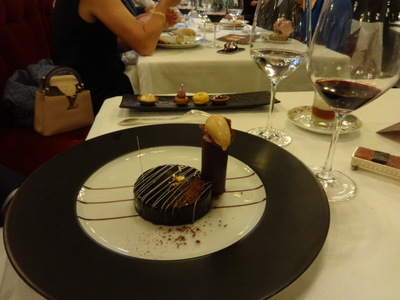
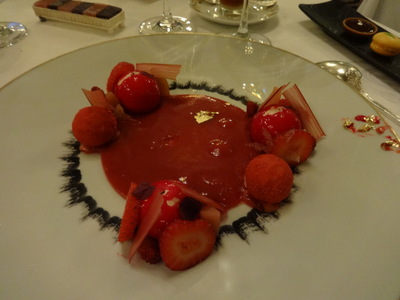 Next came our actual desserts. David had the chocolate-hazelnut dish. Both the round, flat part and the tall cylinder were filled with soft chocolate ganache flavored with hazelnuts.
Next came our actual desserts. David had the chocolate-hazelnut dish. Both the round, flat part and the tall cylinder were filled with soft chocolate ganache flavored with hazelnuts.
I had the strawberry-rhubarb combo. It consisted of a pool in the center of stewed strawberries and rhubarb, surrounded by two balls of strawberry sorbet and three shiny red spheres garnished with thin little planks of dried rhubarb, sliced domestic strawberries, a few actual "fraises des bois" (wild strawberries), and some chunks of stewed rhubarb. The spheres turned out to be white chocolate filled with rhubarb purée and dipped in something bright red. You can't really see them in the photo, but among the garnishes were several littel flat, clear flowers cut out of a sheet of sugar crystal. The dessert was good, once I got to eat it, but you can see on the right-hand edge of the plate the bits of gold leaf I was in the process of picking off when I stopped to take the picture. Restaurants were sticking gold and silver leaf all over desserts all over Paris this year, and I hate it! Yes it's perfectly edible, but you have to get it past your teeth first, and my teeth are full of silver-amalgam fillings. Getting the tiniest bit of that stuff on a filling sets off all sorts of electrochemical reactions. It feels horrible, like electric shocks through your teeth, and the gold is really, really hard to get off once you've bitten a piece; I usually wind up chewing my napkin.
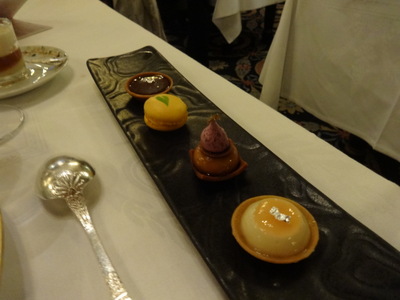
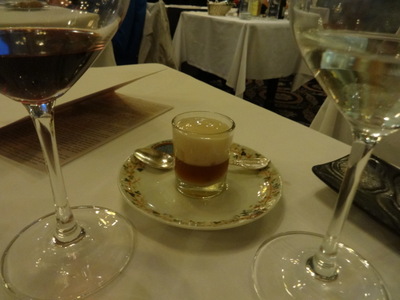 Behind my dessert plate, you can see one of the three dishes of migniardises they brought—a row of fruit-paste cubes, alternating red and gold.
Behind my dessert plate, you can see one of the three dishes of migniardises they brought—a row of fruit-paste cubes, alternating red and gold.
At the left is another, bearing four different tiny tartlets, but not only was I no longer hungry, I was sick of picking gold leaf off things.
The third mignardise, we did eat. It was a little glass for each of us with a tart fruit jelly at the bottom and a foamy sauce on top, tea flavored, I think. They recommended we eat it directly after our desserts, and yes, it definitely helped uncloy the tastebuds after all the sweetness.
Previous entry List of Entries Next entry